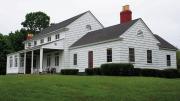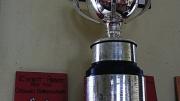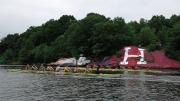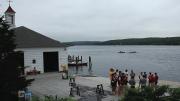The long list of past results is studded with footnotes that illuminate some of the more peculiar races. In 1870, for example, “Yale ran into Harvard, which was leading at the turning stake; Yale disqualified.” In 1890, “Yale stroke broke oar, dove overboard;” in 1971, Yale’s #7 man lost his oar and dove into the same river.In 1911, Yale’s stroke was taken from the shell near the three-mile mark, presumably a victim of exhaustion, a fate that befell an un-footnoted Harvard oarsman in 2007, enabling Yale to come back from a deficit and nip Harvard by half a second.
Let’s not forget the notorious “eelgrass” race of 1882, when “At the mile Yale led by a length of clear water, but the coxswain losing his head steered through a patch of eelgrass near the east shore, owing to which they were 19 seconds behind Harvard at the mile and a half,” according to a Yale historian. The Blue gamely rallied to come back and ultimately lost by only three seconds, despite setting a new Yale course record.
There are many quirky stories partly because there have been so many races: this year’s will be the 145th (Harvard has 90 wins, Yale 54). The Harvard-Yale Boat Race, begun in 1852, is the oldest intercollegiate athletic contest in the United States. The varsity four-mile event is the longest crew race regularly rowed in North America. Its only peer is the even older and longer Oxford-Cambridge Boat Race (4¼ miles), which dates from 1829. Both regattas take place upon the Thames, though the one in Connecticut rhymes with “games.” Harry Parker, the men’s head crew coach, says, “It’s special--a very, very challenging race. It puts a premium on training hard, good determination, and endurance.”
The race training is unique in the world of college sports. Harvard and Yale are the only colleges that maintain special training camps to prepare for a single athletic contest. Harvard’s is called Red Top, after the color of a cupola atop the small boathouse there; Yale’s, a short way upstream, is Gales Ferry, the name of a local town. These camps lie fallow all year until the crews arrive a week or two before their showdown. Only heavyweight men compete in New London: the varsities plus the freshmen (a two-mile race), JVs (three-mile race), and an unofficial “combi crew” (a mix of oarsmen from the third varsity and second freshman boats who race two miles on Friday--before the regatta proper on Saturday--or sometimes on Sunday).
The days leading up to the floating clash are a college oarsman’s version of the Elysian Fields (or streams), a paradise of sorts where there is little to do but row, eat, sleep, and horse around. The Harvard crews row twice daily, in the early morning before breakfast, and in the afternoon. In between, there’s ample time for games of cards (and today, video games) or croquet on the riparian lawns. “They call it croquet,” cautions Ian Gardiner ’68, M.B.A. ’74, former chairman of the Friends of Harvard and Radcliffe Rowing, who stroked the 1967 varsity. “I dare anybody to beat Harry [Parker]. He made up the rules as we went along. There was ample cheating on all sides.”
There can be serious matters to attend to, as well, such as exams: many oarsmen have taken finals at Red Top and “Harry was often the person who gave people their diplomas,” Gardiner explains, because the regatta sometimes conflicted with Commencement. (This year, Harvard’s revised academic calendar means that the race falls on May 29, two days after Commencement.)
“The event has changed so dramatically in terms of its importance in the world,” says Clint Allen ’67, who stroked the undefeated 1966 varsity that finished nine lengths ahead of Yale. In the 1920s and 1930s, as many as 100,000 spectators thronged to New London for the regatta, and a special observation train rolled along the riverbank, enabling its passengers to keep track of the race. As late as 1966, Allen recalls, “There were hundreds of yachts side by side, lining the last half mile of the course. They were all blowing their horns and it was a cacophony.” Allen’s victorious race made the front page of the Boston Globe; today, he says, “You have to hunt in the sports section to find the results,” and spectators number in scores rather than thousands.
Yet spectatorship has never been the primary issue. “The striking thing to me is how participants in the regatta continue to cherish the experience,” Parker says. “They treat it as a really special event, and that’s a large part of why they are so loyal to it.”
Indeed there is a timelessness to Red Top. In the dormitory, “You look at the door of your compartmentand see the names of your predecessors,” says Gardiner. "You are becoming part of history there."











